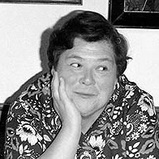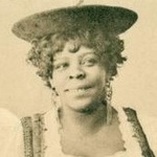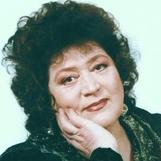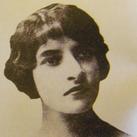
Performed by Ruby Helder.
Score: IMSLP.
Uploaded by Lior Levy.
 Aria of the Week #134: "M'appari tutt' amor" by F. von Flotow. Performed by Ruby Helder. Score: IMSLP. Uploaded by Lior Levy.
0 Comments
 Bally Prell, Contralto Profondo Bally Prell, Contralto Profondo This week's Contralto Update features Bally Prell. Bally Prell wass a German Contralto Profondo from Munich. She was a performer and folk singer who performed mainly in the Baverian dialect. Her unusually dark and resonant tone allowed her to sing arias normally associated with the Lyric Tenor fach. Check out her pages and the video below.  Today's Contralto Update features Arabella Fields. Contralto Profondo Arabella Fields was known as 'The Black Nightingale'. She was native from Philadelphia, PA, but from the 1890s to the 1920s she toured throughout Europe and became one of the most prolific African American entertainers outside the USA. In 1907 she made a couple of recordings for Anker. Check out her page and the video below.  Galina Baranova Galina Baranova This week's Contralto Update features the Russian Contralto Profondo Galina Baranova (Галина Баранова). Galina Baranova was not an opera singer, she was trained in the Leningrad Conservatoire, and her voice has the power and control to perform on the stage of the world's top opera houses. Her voice is that of a rare contralto profondo, with truly cavernous depths, capable of singing well below C3 in to the baritone tessitura. Apart from Gaea in Strauss' Daphne, I am not sure there are many operatic roles she could sing, unless she took on some of the tenor roles! Check out her pages, and the video below. Hello everybody!
After speaking to friends and singers alike, I have decided to amend my proposed nomenclature for those women who sing in the bass tessitura. Previously I proposed the name Oktavistka, a femine form of the Russian term Oktavist. I now think that it would be easier to use and understand the term Contralto Basso. I think it sounds and feels lower than the Contralto Profondo, my name for the female tenor, and is easier to recognise as part of the current Fach system. To recap, I propose the term Contralto Profondo for female tenor, and Contralto Basso for female bass. All the best, James  English contralto Ruby Helder was a contralto profondo known in her time as the "girl tenor". She had a range from C3 to C5, a fine working tenor range, and was praised by such figures as Charles Santley and Enrico Caruso. In fact, Caruso had asked the Metropolitan Opera Company to give Hender some tenor roles in thier productions, though the Met declined to do so. Check out her pages and the video below. I thought it might be useful to clarify to you all my views on the lower fachs of the contralto voice, and on the nomenclature used in my previous post. When discussing those female singers whose voices sit below the accepted range of the contralto, I believe that we should move away from the terms female tenor and female bass. Instead, we should move towards terminology that is more descriptive of the timbre of the voice, and of the method of vocal production engaged to attain the required pitch. It is for this reason that I suggest the terms contralto profondo for female tenor and oktavistka for the female bass. I would like to demonstrate why I believe these terms are more appropriate. In the case of the female tenor, women who sing in the tenor range are using the lowest register, the chest register, for the majority of the notes they produce. They may move into the middle register for the highest notes above F4, but they may also extend the use of the chest register to cover these notes, particularly when required to sing fortissimo. The chest register in any singer is darker and thicker than the other two registers. By contrast, a male tenor is spending the majority of his time in the middle and head registers. The head register of the male tenor is tight and piercing, not cavernous and expansive. Thus, in the case of the female tenor, both the method of producing the notes, and the timbre of the notes themselves, have little in common with the male tenor. In fact, she has more in common with the registration changes of the basso profondo, making the term contralto profondo, rather than female tenor, a more appropriate description of the voice type. The same case can be made for the female bass. We use the term oktavist to describe a male singer who can sing in the octave below the basso profondo. Thus, rather than the term female bass, I suggest the term oktavistka. This term, oktavistka, is not in the Russian dictionary. An academic, who specialises in the Russian language, and who is a colleague of mine, has advised that the suffix –ka feminises the word oktavist. Hence I have used this neologism… To adopt the terms contralto profondo and oktavistka would, I believe, give a greater credibility to the voice types, with respect to both the singers themselves and to their potential audience. “Low ladies” would no longer be seen as “women who sing like men”, but would instead be seen as “women who sing low”. Now that I have explained these terms, I would now like to integrate them into the existing contralto terminology. The three existing contralto voice types are (with the exclusion of the coloratura contralto) the lyric contralto (the highest contralto Fach) the dramatic contralto (the lowest contralto Fach in mainstream opera) and the tiefer alt (the current lowest contralto Fach, which I would consider to be the “Alto 2” of an eight part chorus, and which is seen rarely in opera; the role of Gaea in Strauss’ Daphne being the main example). The contralto profondo would sit below the tiefer alt, and the oktavistka below the contralto profondo. With respect to range, timbre, resonance and vibrato, I would expect a tiefer alt to be comfortable down to Eb3, have a solid D3, and have a possible C3, though it may be raspy and not what one would consider a "soloists" note. The contralto profondo would, I believe, be able to sing down to B2/Bb2, with a full resonant sound of operatic quality, with a full, vibrant vibrato and no vocal wobble. The sound would be richer and darker than the usual contralto sound, with similar qualities to that of the male baritone with respect to vocal colour. Here are two examples of singers that I believe demonstrate the qualities of the contralto profondo Fach.
If the singer could only produce a thin, gravely or harsh sound with a "spoken voice" quality below the notes below Eb3/D3, I would consider the singer to be a Tiefer Alt, and not a contralto profondo.
I hope the above clarifies my thoughts on the Fachs of the contralto voice, and the nomenclature I have used gives a clearer categorisation of the voice types.
The Contralto is the lowest female voice category, and can be split into five vocal fach: Coloratura Contralto, Lyric Contralto, Dramatic Contralto, Contralto Profondo (Female Tenor) and the Oktavistka (Female Bass). Normally, the Dramatic Contralto would tend to have both a heavier and lower voice but, like the Lyric and Dramatic Bass voices, the lighter voiced Lyric Contralto may have a longer chest register extension, and thus a lower range, without having such a dark and powerful sound. An example of a Lyric Contralto is Jeanne Gerville-Réache, while a Dramatic Contralto would be Dame Clara Butt. The Coloratura Contralto can be split into two sub-fach categories, one with a lighter voice, and one with a heavier one: for example Sonia Prina is a Lyric Coloratura Contralto, while Ewa Podles is a Dramatic Coloratura Contralto. Also, just as the Bass can extend far beyond the D2 mark, like the famous Russian Basses or Oktavists, so many a Contralto can sing comfortably below D3. Polish Contralto Ewa Podleś, for instance, has performed an A#2 in concert. Many women sing in the Tenor range, as my own mother can, and some can even sing down to C2, like the Lady-Bass Margaret Jackson-Roberts from Vivaldi's women. Unfortunately, Contraltos are not encouraged to explore this dark, rich lower register, and consequently have to make do singing in the higher reaches of the voice. They are also allocated voice categories which have to be prefaced by the word "Female": Female-Tenor and Female-Bass. I propose that, instead, we use less male-specific words: Contralto Profondo for Female Tenor, and Oktavistka for the Female bass. So, the Contralto Profondo (Female Tenor) and the Oktavistka (Female Bass) would be the female equivalents of the Basso Profondo (think Kurt Moll) and the Oktavist (think Vladimir Miller). Here, there would be a very large chest register extension, droping down to Bb2 for the Contralto Profondo (Female Tenor), and between A2-C2 for the Oktavistka (Female Bass). An example of the Contralto Profondo would be Ruby Helder or Bally Prell, and an example of the Oktavistka would be Margaret Jackson-Roberts. I will be writing a fuller post about the Contralto Profondo (Female Tenor) and the Oktavistka (Female Bass) at a later date, but I think it important to introduce the concepts here. Usually, the Lyric, Dramatic and Coloratura Contraltos should be able to sing, when given an average level of training, the two octaves from E3 to E5. Most Contraltos do not need to sing lower than this, as the prevalent custom is to extend the voice upward, allowing the very lowest notes to atrophy. See the Telegraph article "Where have all the Contralto's gone?" for more about this trend. Many Contraltos could probably easily sing down to D3 or C3 if given proper training in this area of the voice. In his excellent article, "Training the Contralto Voice: Developing Diagnostic Tools for Understanding a Rare Voice Type", David L. Jones lists the major characteristics of the Contralto voice:
He also mentions the fact that the ability to crescendo in the middle register is a quality of the true contralto voice. Negatively, they may have:
Jones also lists the ranges of the various registers for the Contralto voice:
Many of the arias performed by the Contralto, such as those written by Bach and Handel, were actually written for another voice type: Bach's music, with its average range of B3 to E5, was almost certainly written for falsettists, and his Cantata for lower Alto, "Widerstehe doch der Sünde" was most likely composed for a High Tenor, or Haute-Contre. Many of the "Alto-ranged" Handel and Vivaldi arias were in fact written for the Castrati. Thus many of the "Alto-ranged" arias were not actually written with the Contralto voice in mind. This is not to say that Handel, Vivaldi and other Baroque composers did not write for the Contralto voice, as they most certainly did, but that perhaps many of the "Alto" ranged arias did not take advantage of the full potential of the Contralto voice. Many Contraltos have taken roles normally associated with Mezzos, such as Carmen, Dalila and Amneris, and sing them to great effect, but here the Contralto is left singing "out of fach". This trend is also lees likely to occur now, as opera houses are less willing to transpose arias down, or to omit troublesome high-notes. I find it strange that the Contralto voice is so painfully underused, under-admired and under-engaged, given that in the world of popular music, much is made of the lower end of the Contralto spectrum. Singers such as Mariah Carey, Tionne Watkins, Toni Braxton, Beyonce and Alicia Keys all use the lowest area of the Contralto voice, C3 and below, in their music. The roles these women portray in their videos and through their music are varied, ranging from strong to tender, innocent to... well, not so innocent! They are not restricted to the rather limited "witches, bitches and britches" stereotype that operatic contraltos are relegated to. Perhaps it is time for the new generation of composers to wake up to the potential of this great and beautiful voice. |
Dramatic ContraltosMeredith Arwady
Gwendolyn Brown Dame Clara Butt Patricia Forbes Nicole Mitchell Sharmay Musacchio Angela Christine Smith Contralto ProfondosLinksHere are a few links which may prove useful. Blog RollBarihunks Categories
All
Archives
February 2024
|